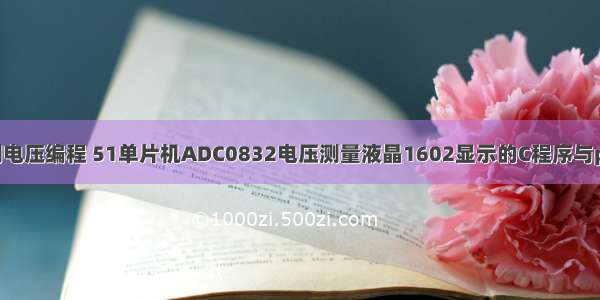
;
stringBuf=stringBuf[length-i-1];
stringBuf[length-i-1]=t;
}
stringBuf[length]='\0';
return length;
}
//蜂鸣器
//延时函数 毫秒 @12.000MHz
void DelayMS(uint ms)
{
uchar i, j;
while(ms--)
{
_nop_();
i = 2;
j = 239;
do
{
while (--j);
}while (--i);
}
}
//延时函数 20微秒 @12.000MHz
void Delay20us()
{
uchar i;
_nop_();
i = 7;
while (--i);
}
//定时器0中断
void Timer0() interrupt 1
{
}
//DS18B20代码:
#include
#include
#define uchar unsigned char//无符号8位
#define uint unsigned int //无符号16位
//定义DS18B20端口DS18B20_DQ
sbit DS18B20_DQ = P2^7;
//当前采集的温度值整数部分
int xdata CurTempInteger;
//当前采集的温度值小数部分
int xdata CurTempDecimal;
void Delayus(uint count)
{
while (--count);
}
uchar Reset_DS18B20()
{
uchar status;
DS18B20_DQ=1;
Delayus(1);
//开始复位过程
DS18B20_DQ=0;//数据线拉低
Delayus(100);//延时480us-960us
DS18B20_DQ=1;//数据线拉高
Delayus(10);//延时15us-60us
status=DS18B20_DQ; //读取数据线上的状态
Delayus(120);
return status;
}
voidWriteByteToDS18B20(uchar dat)
{
uchar i;
for(i=0;i<8;i++)
{
DS18B20_DQ=0;
DS18B20_DQ=dat&0x01; //发送1位数据
Delayus(15); //延时60us以上
DS18B20_DQ=1; //释放总线,等待总线恢复
dat>>=1; //准备下一位数据
}
}
uchar ReadByteFromDS18B20()
{
uchar i,dat=0;
for(i=0;i<8;i++)
{
DS18B20_DQ=0; //拉低总线,产生读信号
dat>>=1;
DS18B20_DQ=1; //释放总线,准备读1位数据
Delayus(2); //延时4us
if(DS18B20_DQ) dat|=0x80; //合并每位数据
Delayus(15); //延时60us
DS18B20_DQ=1; //拉高总线,准备读下1位数据
}
return dat;
}
void ReadTemperatureFromDS18B20()
{
uchar flag=0;//正负符号标志
//存储当前采集的温度值
uchar TempValue[]={0,0};
if(Reset_DS18B20())
{
CurTempInteger=255;
CurTempDecimal=0;
}
else
{
WriteByteToDS18B20(0xCC);//跳过ROM命令
WriteByteToDS18B20(0x44);//温度转换命令
Reset_DS18B20();//复位
WriteByteToDS18B20(0xCC);//跳过ROM命令
WriteByteToDS18B20(0xBE);//读取温度暂存器命令
TempValue[0]=ReadByteFromDS18B20();//先读低字节温度值
TempValue[1]=ReadByteFromDS18B20();//后读高字节温度值
Reset_DS18B20();//复位
//计算温度值
//先进行正温度与负温度判断,高5位全为1(0xF8)则为负数
if((TempValue[1]&0xF8)==0xF8)
{
//负温度计算:取反加1,低字节为0时,高字节取反加1,否则不需要。
TempValue[1]=~TempValue[1];
TempValue[0]=~TempValue[0]+1;
if(TempValue[0]==0x00) TempValue[1]++;
flag=1;//负数标志
}
//将温度值分为整数和小数两部分存储(默认为12位精度)
CurTempInteger=((TempValue[1]&0x07)<<4)|((TempValue[0]&0xF0)>>4); if(flag) CurTempInteger=-CurTempInteger;
CurTempDecimal=(TempValue[0]&0x0F)*625;
}
}
//LCD1602程序代码:
#include
#include
#define uchar unsigned char
#define uintunsigned int
#define Delay4us(){_nop_();_nop_();_nop_();_nop_();}
sbit LCD_RS=P2^0;
sbit LCD_RW=P2^1;
sbit LCD_EN=P2^2;
void LCDDelay(uint ms)
{
uchar i, j;
while(ms--)
{
_nop_();
i = 2;
j = 239;
do
{
while (--j);
}while (--i);
}
}
bit LCD_Busy_Check()
{
bit result;
LCD_RS=0; LCD_RW=1; LCD_EN=1;
Delay4us();
result=(bit)(P0&0x80);
LCD_EN=0;
return result;
}
void Write_LCD_Command(uchar cmd)
{
while(LCD_Busy_Check());
LCD_RS=0; LCD_RW=0;LCD_EN=0; _nop_(); _nop_();
P0=cmd; Delay4us();
LCD_EN=1; Delay4us(); LCD_EN=0;
}
void Write_LCD_Data(uchar dat)
{
while(LCD_Busy_Check());
LCD_RS=1;LCD_RW=0;LCD_EN=0;
P0=dat;Delay4us();
LCD_EN=1;Delay4us();LCD_EN=0;
}
void LCD_Set_POS(uchar pos)
{
Write_LCD_Command(pos|0x80);
}
void LCD_Initialize()
{
Write_LCD_Command(0x01); LCDDelay(5);
Write_LCD_Command(0x38); LCDDelay(5);
Write_LCD_Command(0x0C); LCDDelay(5);
Write_LCD_Command(0x06); LCDDelay(5);
}
void LCD_Display_String(uchar *str, uchar LineNo)
{
uchar k;
LCD_Set_POS(LineNo);
for(k=0;k<16;k++)
{
Write_LCD_Data(str[k]);
}
}
void LCD_Display_OneChar(uchar Dat, uchar X, uchar Y)
{
Y &= 0x01; //限制Y不能大于1(2行,0-1)
X &= 0x0F;//限制X不能大于15(16个字符,0-15)
if(Y) {X |= 0x40;} //当要在第二行显示时地址码+0x40;
X |= 0x80; //算出指令码
Write_LCD_Command(X);
Write_LCD_Data(Dat);
}
















